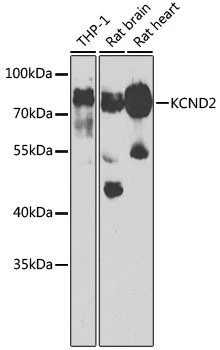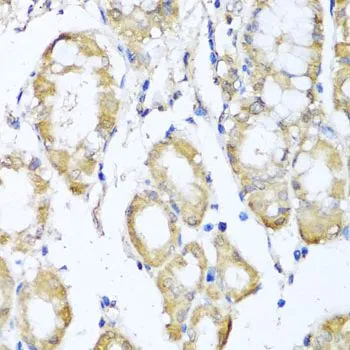
WB analysis of various sample lysates using GTX54373 Kv4.2 antibody. Dilution : 1:1000 Loading : 25microg per lane
Kv4.2 antibody
GTX54373
ApplicationsWestern Blot, ImmunoHistoChemistry, ImmunoHistoChemistry Paraffin
Product group Antibodies
TargetKCND2
Overview
- SupplierGeneTex
- Product NameKv4.2 antibody
- Delivery Days Customer7
- Application Supplier NoteWB: 1:500 - 1:2000. IHC-P: 1:50 - 1:200. *Optimal dilutions/concentrations should be determined by the researcher.Not tested in other applications.
- ApplicationsWestern Blot, ImmunoHistoChemistry, ImmunoHistoChemistry Paraffin
- CertificationResearch Use Only
- ClonalityPolyclonal
- ConjugateUnconjugated
- Gene ID3751
- Target nameKCND2
- Target descriptionpotassium voltage-gated channel subfamily D member 2
- Target synonymsKV4.2, RK5, A-type voltage-gated potassium channel KCND2, potassium channel, voltage gated Shal related subfamily D, member 2, voltage-gated potassium channel subunit Kv4.2, voltage-sensitive potassium channel
- HostRabbit
- IsotypeIgG
- Protein IDQ9NZV8
- Protein NameA-type voltage-gated potassium channel KCND2
- Scientific DescriptionVoltage-gated potassium (Kv) channels represent the most complex class of voltage-gated ion channels from both functional and structural standpoints. Their diverse functions include regulating neurotransmitter release, heart rate, insulin secretion, neuronal excitability, epithelial electrolyte transport, smooth muscle contraction, and cell volume. Four sequence-related potassium channel genes - shaker, shaw, shab, and shal - have been identified in Drosophila, and each has been shown to have human homolog(s). This gene encodes a member of the potassium channel, voltage-gated, shal-related subfamily, members of which form voltage-activated A-type potassium ion channels and are prominent in the repolarization phase of the action potential. This member mediates a rapidly inactivating, A-type outward potassium current which is not under the control of the N terminus as it is in Shaker channels. [provided by RefSeq, Jul 2008]
- Storage Instruction-20°C or -80°C,2°C to 8°C
- UNSPSC12352203







